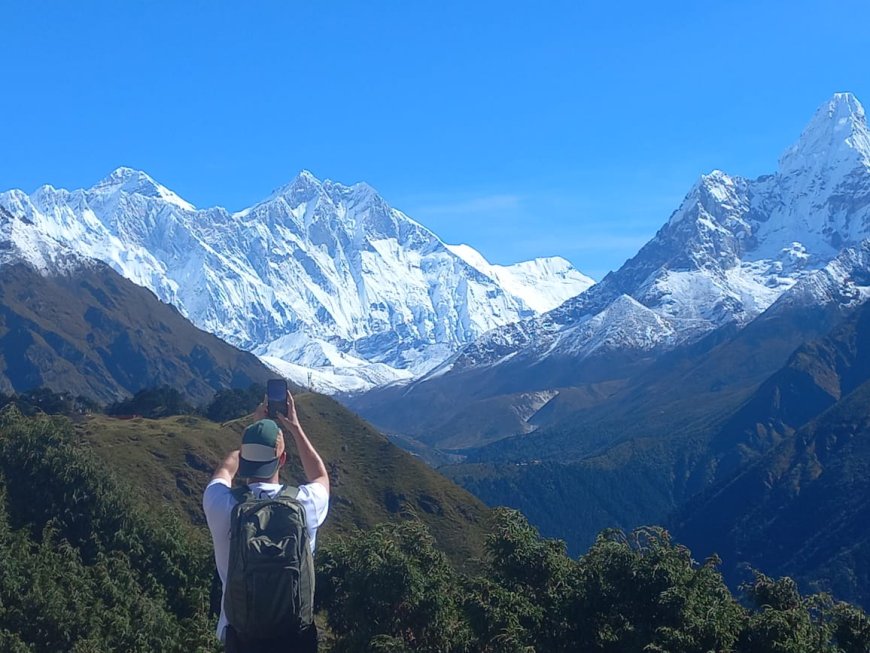How To Avoid Painful Mistakes On Your First ABC Trek
Planning your first Annapurna Base Camp trek? Learn how to avoid common mistakes like altitude issues, poor packing, and timing errors to make your ABC adventure safe, smooth, and unforgettable.

How To Avoid Painful Mistakes On Your First ABC Trek
The Annapurna Base Camp trek (ABC Trek) is one of the best spots in Nepal, with amazing mountain views and cool cultural experiences. But if it's your first time, some common mistakes can turn your dream trip into a tough one. Being prepared is super important for staying safe and having fun.
One big mistake is not taking altitude seriously. Being at 4,130 meters means altitude sickness can hit anyone, even if the climb is gradual. Don't rush things. Take those acclimatization days to heart, drink plenty of water, and steer clear of alcohol. If you start feeling dizzy or nauseous, its time to go back down.
Another common error is packing too much. Many trekkers end up burdened with unnecessary gear. Pack light and stick to the essentials: good layered clothing, a solid down jacket, rain gear, and sturdy boots. A small first-aid kit and water purification tablets can really help too.
A lot of folks underestimate how tough the trail can be. Not training enough can lead to sore knees, blisters, and feeling worn out. Get in some cardio, hiking, and stair climbing in the weeks leading up to your trek.
Choosing the wrong time to go can also be a problem. Avoid the monsoon season (JuneAugust) because of leeches and muddy paths. The best times are from March to May and September to November, when the weather is stable and the views are clear.
Lastly, be careful with your time budget. Rushing through ABC is a big mistake; make sure to add some extra days for rest, delays, or bad weather.
To really enjoy your ABC trek, do your homework, train ahead, be mindful of the altitude, and pack smart. A little planning can make a huge difference between a tough hike and an unforgettable adventure. Avoid these first-timer mistakes, and youll be rewarded with incredible views and meaningful experiences in the heart of the Himalayas.
Underestimating the Trek Difficulty
A lot of new trekkers think the Annapurna Base Camp trek is just a casual walk in the hills. But the reality is, it involves days of hiking up steep stone steps and climbing to high altitudes. You dont need mountaineering skills, but you do need endurance and the ability to stay mentally strong. If you dont take the effort seriously, you might end up with sore muscles or even have to cut your trip short. The trail can change a lot, from humid forests to chilly alpine areas, so be ready for anything. Treat this trek as a real challenge, not just a pretty view. Take breaks, fuel up with proper meals, and pay attention to how you feel. If you're prepared, the rewards are fantastic. If you're not, it can be overwhelming.
Ignoring Altitude Sickness Warnings
Altitude sickness is a real concern on the ABC trek, especially once you pass 2,500 meters and head up to 4,130 meters at base camp. A common mistake is to ignore symptoms like headaches and dizziness, thinking theyll pass. But these are signals that your body needs a break. Taking a rest day, staying hydrated, and moving slowly can help prevent serious issues. Some trekkers bring Diamox, but remember, it should be used alongside good acclimatization habits. Dont push through just to keep on scheduleyour health is more important than rushing. Everyone reacts to altitude differently, so listen to your body.
Packing the Wrong Gear
What you bring can affect your ABC trek experience. Many newbies either pack way too much or choose the wrong stuff, like heavy jeans or low-quality boots. These can weigh you down and make hiking uncomfortable. Others pack too lightly and end up cold or wet. Stick with moisture-wicking layers, a solid rain jacket, a good sleeping bag, and dependable hiking boots. Dont forget basics like a headlamp, a power bank, sunscreen, and a water purifier. Make sure your gear works well before your trip. Pack smartevery item in your bag should be useful. Your comfort and safety depend on how well you prepare.
Skipping Physical Preparation
One major mistake is showing up for the trek without being in shape. This is a multi-day hike with uphill climbs and rocky paths, especially those steep stone steps near Ulleri and Deurali. If you havent trained, youll wear out fast, which can lead to injuries. To get ready, focus on cardio exercises like hiking or jogging, build your leg strength, and stretch regularly. Practicing with a packed backpack can help your body adjust. You dont need to be a pro athlete, but you do need stamina. Training ahead of time makes the trek more enjoyable and helps you soak in the sights and culture without feeling wiped out.
Starting Too Late in the Day
A late start can mess up your trekking day. Morning weather in the Himalayas is often clearer and calmer, while afternoons can bring clouds and storms. If you begin late, youll have to deal with the hot sun, reach tea houses when they might be full, and risk hiking in the dark. Try to start by 7:00 a.m. to make the most of the good weather and have enough time for breaks. Early starts also mean better trail conditions, so youll arrive at your next stop ready to relax or check out the village. Good timing makes for a smoother and safer trek.
Not Carrying Enough Cash
While you can find ATMs in Pokhara, the ABC route doesnt have them after Nayapul. Everything past that point is cash-onlylike food, accommodations, and even shower fees. Prices can go up with altitude, and you might face unexpected costs. Many trekkers dont budget enough and run short on cash. Bring enough to cover your whole trek, plus a little extra for emergencies. Break it into smaller amounts and keep it safe. Dont plan on borrowing money in remote areasrunning out could leave you in a tough spot.
Forgetting Trekking Permits
You cant enter the Annapurna Conservation Area without the right permits. Unfortunately, some trekkers forget to get them or think they can sort it out on the trail. Youll need two permits: the ACAP and the TIMS card. You can easily get these in Pokhara or Kathmandu, but remember to bring your passport and a couple of passport-sized photos. Forgetting them means you might have to turn back or pay fines. You need to show these permits at various checkpoints along the way, so keep them handy. Plus, getting the permits helps with local conservation efforts.
Overpacking or Underpacking Essentials
Packing too much can slow you down and cause discomfort. If you pack too little, you might find yourself cold or unprepared for rain. Some trekkers bring unnecessary items like books or multiple outfits and forget essentials like a headlamp or a first aid kit. Aim for a balanced pack: bring only what you need. Must-haves include layered clothing, a sleeping bag, sun protection, and basics for first aid. Using a packing list can help you avoid last-minute panic. The lighter your load, the easier your trek will bejust make sure you dont leave behind anything important.
Disrespecting Local Culture and Etiquette
The ABC trek goes through villages with rich Nepalese and Tibetan cultures. Not respecting local customsknowingly or notcan create issues and affect how trekkers are viewed. Dress modestly, speak kindly, and ask before taking photos. Avoid touching peoples heads, pointing with your feet, or wearing shoes in temples. Public displays of affection are usually considered rude. Also, its good practice to eat where you sleep; buying meals at your tea house helps support local families. Learning a few basic Nepali phrases like Namaste or Dhanyabad (thank you) shows respect. Being mindful of local culture not only earns you appreciation but also enhances your experience.
Not Having a Backup Plan for Weather or Delays
Himalayan weather can be unpredictable. Clear mornings can quickly turn into rainy afternoons, and trails can get blocked by landslides or snow. Many trekkers plan tight schedules and feel stressed when delays happen. Build in some extra days before and after your trek, especially if you have flights to catch. Always pack waterproof gear, a rain cover for your backpack, and some cash for emergencies. If you have flights in or out of Pokhara, be ready for possible delays. Its smart to download offline maps, share your itinerary with someone, and know where to find help if needed. A little bit of flexibility can make your trek much more enjoyable, even when things dont go exactly as planned.
Is ABC Trek good for beginners?
Yep, the Annapurna Base Camp trek is pretty beginner-friendly if you're in decent shape. You wont need any climbing skills, but be ready for long hikes, some big elevation changes, and rough paths. If you prepare well and take your time to adjust to the altitude, you can finish the trek. The trail is easy to follow, and there are lots of tea houses along the way for breaks, so its a great option for first-time trekkers looking for a Himalayan experience.
How should I get ready for the ABC Trek?
To prep, focus on getting your cardio up, building leg strength, and boosting your endurance weeks ahead of your trek. Stuff like hiking, jogging, stair climbing, and strength exercises can help. Also, practice walking with a backpack loaded like youll have on the trek. Know the signs of altitude sickness and make sure to pack the right gearlayered clothes, good boots, and a solid sleeping bag. Its also smart to plan your itinerary with rest days for adjusting to the altitude and to sort out any permits youll need ahead of time.
How tough is the ABC trek?
The ABC trek is considered moderate in difficulty. Its not technically hard, but it does push you with long daily hikes (about 5-7 hours), steep climbs, and heights over 4,000 meters. The ground can change a lot from wooded trails to rocky paths. Being fit and adjusting to the altitude are key to handling this trek comfortably.
What steps should you take while trekking?
Some important steps include getting in shape before you go, taking your time to adjust to the altitude to avoid sickness, staying hydrated, and packing the right clothes and gear for changing weather. Let someone know your plans, carry your trekking permits, and respect local customs. Its smart to have a basic first-aid kit and to know how to get help if needed. Always start your hikes early and dont push yourself too hard to stay safe.























